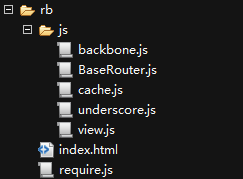这两个轻量级的库合起来使用确实能够方便的构建大型应用程序。RequireJS填补了前端模块化开发的空缺,Backbone采用MVC的分层结构很好的将程序各个部分解耦。
Backbone目前不支持AMD(曾经支持过),那么它只能作为普通的JS文件使用。它全局的标示符是Backbone,它还依赖于underscore,underscore的全局标示是下划线(_)。
因此,当我们使用AMD方式写的模块中使用Backbone时,得确保underscore和Backbone已经载入了。
RequireJS 2.0后提供了一个shim参数很好的解决了该问题。
示例目录

js目录中有underscore.js,backbone.js。其中cache.js不依赖于Backbone,BaseRouter.js依赖。
index.html如下
|
1
2
3
4
5
6
7
8
9
10
11
12
13
14
15
16
17
18
19
20
21
22
23
|
<!doctype html>
<
html
>
<
head
>
<
title
>RequireJS和Backbone集成</
title
>
<
meta
charset
=
"utf-8"
/>
<
script
src
=
"require.js"
></
script
>
<
script
>
require.config({
baseUrl: 'js',
shim: {
'backbone': {
deps: ['underscore'],
exports: 'Backbone'
}
}
});
require(['BaseRouter'], function(baseRouter) {
});
</
script
>
</
head
>
<
body
>
</
body
>
</
html
>
|
注意,require.config配置了shim参数,shim参数这里有介绍。
这样配置后,当其它模块依赖于Backbone(如BaseRouter),它会顺序下载underscore.js和backbone.js。
BaseRouter内就可以把backbone当成AMD模块来使用了。
|
1
2
3
4
5
6
|
define([
'backbone'
,
'cache'
],
function
(Backbone, cache){
// todo with Backbone and other module
console.log(Backbone);
console.log(cache);
return
{};
})
|
把目录rb放到apache或其它web服务器上,访问index.html。

可以看到所有依赖的文件都依次下载了。在BaseRouter内部就可以使用Backbone了。
相关:
http://stackoverflow.com/questions/10933541/how-to-nested-use-require-js-with-backbone-js




 本文介绍了如何使用RequireJS和其shim参数解决Backbone不支持AMD规范的问题,实现前端模块化开发。通过示例展示了如何配置RequireJS加载Backbone及其依赖的underscore库。
本文介绍了如何使用RequireJS和其shim参数解决Backbone不支持AMD规范的问题,实现前端模块化开发。通过示例展示了如何配置RequireJS加载Backbone及其依赖的underscore库。
















 902
902

 被折叠的 条评论
为什么被折叠?
被折叠的 条评论
为什么被折叠?








